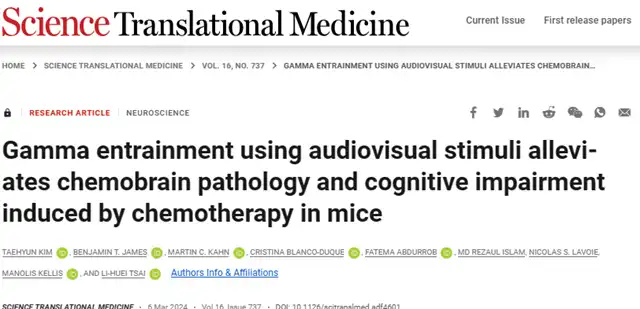Scientists Clear Chemo Brain with Simple Light and Sound Therapy
- Normal Liver Cells Found to Promote Cancer Metastasis to the Liver
- Nearly 80% Complete Remission: Breakthrough in ADC Anti-Tumor Treatment
- Vaccination Against Common Diseases May Prevent Dementia!
- New Alzheimer’s Disease (AD) Diagnosis and Staging Criteria
- Breakthrough in Alzheimer’s Disease: New Nasal Spray Halts Cognitive Decline by Targeting Toxic Protein
- Can the Tap Water at the Paris Olympics be Drunk Directly?
Scientists Clear Chemo Brain with Simple Light and Sound Therapy
- Should China be held legally responsible for the US’s $18 trillion COVID losses?
- CT Radiation Exposure Linked to Blood Cancer in Children and Adolescents
- FDA has mandated a top-level black box warning for all marketed CAR-T therapies
- Can people with high blood pressure eat peanuts?
- What is the difference between dopamine and dobutamine?
- How long can the patient live after heart stent surgery?
Scientists Clear Chemo Brain with Simple Light and Sound Therapy
If you or someone you know has undergone chemotherapy, you may be familiar with the side effect commonly known as “chemo brain.” Scientists have now demonstrated a simple method to protect brain cells from damage using specific frequencies of flashing lights and sounds.
Chemotherapy is one of our best methods for treating many cancers, but unfortunately, its effects extend throughout the body, including the brain. Patients often experience “brain fog,” which involves problems with memory, attention, and decision-making, affecting their thinking and behavior. While these symptoms typically resolve after chemotherapy ends, they can be significantly disruptive to daily life for several months.
However, a new study by researchers at the Massachusetts Institute of Technology (MIT) may have found a rather simple treatment that can eliminate these adverse effects, and importantly, it is less traumatic than the chemotherapy itself. All you need to do is watch some flickering lights and listen to some sounds every day.

Previous research by the group found that flashing lights at a frequency of 40 hertz and sounds at the same tone can stimulate the brain to produce more gamma oscillations. These brain waves, which occur at frequencies between 25 and 80 hertz, are generated during periods of high alertness and help with focused attention. Since Alzheimer’s patients seem to have issues with these gamma waves, the MIT research team wanted to see if this could be a simple treatment to improve their symptoms.
Indeed, experiments on mice showed that after light and sound therapy, inflammation decreased, levels of toxic proteins believed to lead to neurodegeneration reduced, and cognitive tests improved. In their new study, the MIT researchers turned their attention to another condition—chemo brain.
The research team tested this therapy on mice with chemo brain, giving them the common chemotherapy drug cisplatin for five days, followed by a five-day break, then another five days of treatment, mimicking the dosing regimen in humans. Some mice received the “gamma therapy,” being exposed to 40-hertz light and sound for an hour daily, while the control group only received chemotherapy.
After three weeks, the control group mice showed many known effects of chemotherapy on the brain, including reduced brain volume, DNA damage, inflammation, and damage to the protective myelin sheath around neurons. The number of cells producing myelin, called oligodendrocytes, also decreased.
However, the mice that received gamma radiation therapy during chemotherapy showed significant alleviation of all these symptoms. They also performed better in tests measuring animal memory and executive function. When analyzing gene expression, researchers found that genes related to inflammation and cell death were suppressed in mice receiving gamma therapy.
“This therapy reduces DNA damage, reduces inflammation, and increases the number of oligodendrocytes, which are cells that produce myelin around axons,” said senior author of the study, Li-Huei Tsai. “We also found that this therapy improves animal learning and memory and enhances animal executive function.”
The benefits of gamma therapy were found to last at least in part for four months after treatment. The study found that gamma therapy is more effective when performed concurrently with chemotherapy rather than starting after chemotherapy. Subsequent studies found similar positive effects in mice treated with another chemotherapy drug, methotrexate. While the mouse trials involved directly delivering light and sound to neurons via brain implants, previous human trials for Alzheimer’s disease indicated that similar effects could be achieved using synchronized screens and speakers. If successful, this could become a standard setup for patients undergoing chemotherapy, reducing the discomfort associated with life-saving treatments.
The research team also plans to test gamma therapy for other neurological disorders such as Parkinson’s disease and multiple sclerosis. Clinical trials for human Alzheimer’s patients are already underway.
The study was published in the journal *Science Translational Medicine*.
Scientists Clear Chemo Brain with Simple Light and Sound Therapy
(source:internet, reference only)
Disclaimer of medicaltrend.org
Important Note: The information provided is for informational purposes only and should not be considered as medical advice.



